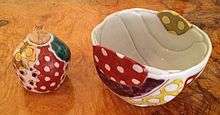Matsuda Yuriko
Matsuda Yuriko (born 1943) is a Japanese ceramic artist.[1]

Work and accomplishments
She was a visiting artist in the exhibition ‘Soaring Voices’, which focused on female Japanese ceramic artists. Her work is in The Brooklyn Museum, The Yale Art Gallery, the Spencer Museum of Art at the University of Kansas,[2] and the San Antonio Museum of Art, among others.
Themes and influences
Matsuda’s work is often centered on body shapes, painted with bright colors, and hand-built. Her forms are irregular and playful, often dealing with themes of parody and exaggeration. Her works range from ceramic feet, teapots mounted with bananas, irregular vessels decorated with eggplants, ceramic buttocks, and roller skates, all handcrafted and colorfully painted.[3] Her work shares elements with Dadaism, sharing playful elements with Man Ray and Elsa Schiaparelli. It often depicts decorations in red enamel with gold kinrande detailing, in the style of Imari porcelain export wares.[4] Matsuda’s work subverts the traditional Japanese uses of colored glazes and gold patterning by applying them to a pair of porcelain feet, mounted on wooden blocks.[5] Her work is not designed for strict functionality. Rather, they diverge from witty cultural commentary to self-expression.
This break from tradition may be linked to the exclusion of women from the ceramic arts in Japan.[6] Despite Japan’s long history of ceramic arts, Matsuda’s work may be read as springing from the post-war alternatives to traditional Japanese forms and the apprentice system.[7] As women studied ceramics in universities, they broke from the traditional apprentice system, which created functional and artistic vessels. (The apprentice system relegated women to the outskirts of production, from decoration to adding glazes.) Women remained on the periphery of the ceramic world until the education and material post-war developments of broadly available universities and the more common appearance of gas and electric kiln.[8] After World War II, Japanese ceramic work shifted in more sculptural, experimental, and expressive directions.
References
- Chang, Beatrice; Spear, Geoff (2006). Fired With Passion: Contemporary Japanese Ceramics. New York: Eagle Art Publishing. ISBN 1891640380. Retrieved 9 April 2015.
- "Matsuda Yuriko, Teapot with Eggplant". http://collection.spencerart.ku.edu. Spencer Museum of Art. Retrieved 9 April 2015. External link in
|website=(help) - "Yale University Art Gallery, Polka-dot Tea Bowl". http://ecatalogue.art.yale.edu. Yale University. Archived from the original on 15 April 2015. Retrieved 9 April 2015. External link in
|website=(help) - Reif, Rita. "ARTS/ARTIFACTS; Japanese Ceramics Take Forms Human And Otherworldly". https://www.nytimes.com. New York Times. Retrieved 9 April 2015. External link in
|website=(help) - Sano, Emily. "Ancient to Modern: Japanese Contemporary Ceramics and Their Sources" (PDF). https://www.samuseum.org. San Antonio Museum of Art. Retrieved 9 April 2015. External link in
|website=(help) - Earle, Joe; North, Halsey; North, Alice (2005). Contemporary Clay : Japanese Ceramics for the New Century. Boston, MA: Museum of Fine Arts Boston. ISBN 0878466967.
- "Contemporary Clay: Japanese Ceramics for the New Century". http://artdaily.com. Art Daily. Retrieved 9 April 2015. External link in
|website=(help) - Chatenever, Rick. "Soaring Voices". mauimagazine.net. Retrieved 9 April 2015.